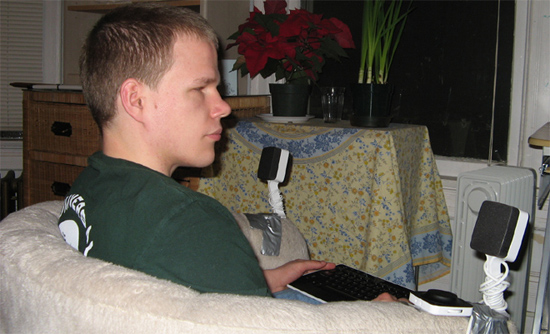
How many people in the world do you think can play a video game without even looking at it? Probably none right? (WRONG!)
Meet Terry Garrett, who lost his sight at 10 years old but never lost his love of video games. In fact, the 23-year-old not only PLAYS video games … but he actually BEATS them.
But how on earth does someone who can’t even see successfully complete an entire video game? Well, it’s pretty simple. He just pays close attention to the sounds and maps out the images in his head. Okay, that’s not really “simple” … but you get the idea. The whole point of this is: A blind guy can play (and BEAT) a frikkin’ video game!
Read the awe-inspiring story below!
When Terry Garrett plays Oddworld: Abe’s Oddysee, he pays close attention to the videogame’s sounds.
The beep of a blinking bomb, the desperate cry of a friend in need, the pounding of a Mudokon’s hammer: They all provide crucial details that enable Garrett to get through the game’s punishing levels. When he needs orientation, Garrett listens carefully for “sound landmarks” like running water or footsteps shifting from grass to earth. And as he works his way through the side-scrolling puzzler’s world of weird creatures, Garrett pieces the noises together and sees the game’s levels laid out in his mind.
Proper listening is essential for Garrett to enjoy the game — after all, he is blind.
Garrett lost his sight in 1997 at age 10. That same year, his older brother brought home Oddworld: Abe’s Oddysee. Entranced by the game’s charming narrator, Abe — a Mudokon slave with his lips sewn shut — Garrett set out to make his way through Oddworld’s danger-filled settings.
Although he couldn’t see a single image on the computer screen, he could hear the sounds — footsteps, voices, music. At first he couldn’t figure out what all the noises meant. Frustrated, he tossed the game aside. But he came back again. And again.
Today, Garrett can beat the entire game, executing every jump and step with near-perfect precision. He’s honed his hearing to the point where he can recognize exactly which sounds refer to each object and act accordingly. He hasn’t memorized every level, but he knows enough about the sound design to beat Oddworld without dying.
“Through Abe’s sounds, I was able to figure out how to navigate the world,” Garrett, now an engineering student at the University of Colorado at Colorado Springs, told Wired.com in an e-mail.
Garrett’s unlikely accomplishments underscore the importance of good sound design in videogames. When was the last time you paid attention to the clang of a sword, or the patter of your character’s footsteps?
To most gamers, sound effects are just part of the scenery, supplemental features that we often take for granted. But to the visually impaired, sound is everything.
Oddworld isn’t the only videogame Garrett can enjoy. He loves games with haptic feedback like Wii Sports and Rock Band, which he learned how to play through a button-mashing period of trial and error.
Some games are nearly impossible for him, even with help. Retro two-dimensional games don’t have enough sound cues. Explosion-packed shooters like Halo are so chock-full of noises that they overwhelm Garrett’s carefully trained ear.
“You hear shots, but can’t tell which direction they are coming from, and by the time you hear them, you are dead,” he said.
The sound design of Abe’s Oddysee was not tailored for the visually impaired. In fact, Oddworld creator Lorne Lanning said it never occurred to him that blind gamers would be able to play through the title.
“It’s quite inspiring to see what was enabled through what we believed were just good solid interactive storytelling details,” Lanning said in an e-mail to Wired.com.
To make games more accessible for gamers with vision problems, sound designers “should include as many sounds as possible,” indicating things like a player’s footsteps, in-game obstacles or approaching enemies, Garrett said.
Matt Uelmen, a sound designer who has worked on Blizzard Entertainment’s StarCraft and Diablo, said making videogames fun for the blind isn’t that easy. “It would definitely require much more attention to sound implementation than most projects are able to give,” Uelmen said. “You’re at the mercy of the animation. If the character does nothing which generates sound, it is hard to rationalize creating too much .”
But Oddworld’s Lanning said someone like Garrett, “who just doesn’t seem to acknowledge the obstacles that so many of us are bogged down by,” could help design innovative games in the future.
Garrett’s current challenge is mastering one of the most beloved games of all time: The Legend of Zelda: Ocarina of Time. He plays the Nintendo 64 game on his PC using an emulator and an Xbox 360 controller.
After listening intently as friends played through sections of the game, Garrett asked them questions and researched Zelda, based on text and video walk-throughs. Actions that require pixel-perfect precision, like shooting arrows or finding targets with the game’s grappling hook, still stymie him.
“I have been trying to pass [Zelda] for over a year,” Garrett said. He can make it to the Water Temple, roughly halfway into Ocarina of Time’s sprawling adventure, with no help at all.
Lanning says Garrett’s story has already inspired tens of thousands of people through YouTube and other communities.
“There’s a lot of gratitude brought to the surface that surrounds this story,” he said. “It’s wonderful to see — a testament to the power and potential of the [videogame] medium.”
So the next time you tell yourself you can’t do something because of an issue or unfortunate circumstance … just think of this guy!














